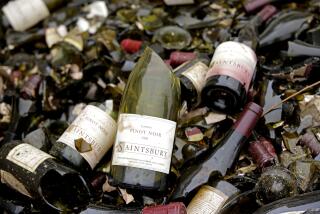Mourvèdre grape a Paso Robles specialty
It’s hard to pronounce, and it can make wines that smell gamy. But Mourvèdre just might be the best grape grown in Paso Robles, one of California’s hottest wine regions.
Mourvèdre (more-VEH-dra) has strong endorsements from two leaders of the region. Tablas Creek’s French founders chose Paso Robles for their first American winery in large measure because they saw it as ideal for Mourvèdre. And Justin Smith, owner of Saxum, says Mourvèdre is the grape that got him into Rhône-style wines in the first place.
Mourvèdre plays an important role in Paso’s biggest acknowledgement as a wine region yet: Wine Spectator’s 2010 Wine of the Year, the 2007 Saxum “James Berry Vineyard” red blend, is 31% Mourvèdre. Yet it’s rare to see it on the front of a wine label, because it’s almost always blended with other Rhône grapes. The classic combo is nicknamed “GSM” — Grenache-Syrah-Mourvèdre — though in Paso, perhaps it should be MSG.
“Mourvèdre is great here,” says Saxum owner-winemaker Smith. “Ever since the beginning, when we used to bottle things like Syrah as a varietal, we would throw Mourvèdre in it. As we learn more about it viticulturally, we’re increasing the portion of it. It has texture and weight and ripeness. It’s a great foil for Grenache, which is high-alcohol and high-acid in this area. Mourvèdre is lower in acid and alcohol, so they really work well together.”
Under the alias Mataro, Mourvèdre has been grown in California for more than 130 years. But it’s a finicky grape that has declined as farmers have gotten fed up with it. The U.S. Department of Agriculture listed only 906 acres of it in California in 2009, making it the 18th-most-grown red wine grape behind obscurities such as Alicante Bouschet and Rubired. More than 20% of the state’s plantings are in San Luis Obispo County, which includes Paso Robles.
Along with Bandol, France, Paso Robles may be one of the world’s few perfect sweet spots for Mourvèdre. It’s sunny and hot during the day and cooler at night. The growing season is extremely long, and there’s enough annual rainfall, because Mourvèdre vines get thirsty. Plus, Paso Robles has the limestone soils that most of Northern California lacks.
“Mourvèdre is the favorite grape here [at the winery], without a doubt,” says Tablas Creek winemaker Neil Collins. The winery’s top blend, the elegant Esprit de Beaucastel, is based on Mourvèdre.
But Mourvèdre is not a grape for novice winemakers. It’s prone to oxidation and contamination with brettanomyces, a type of yeast that makes wines funky. “Brett” lives on grape skins and in used wooden barrels and can develop in any untreated wine, giving it aromas described as “barnyard” or “Band-Aid.” Most winemakers call brett a flaw, but its connection with Mourvèdre is so long-established in France that such a classification remains controversial.
“Mourvèdre has a really bad reputation in the States because so many Mediterranean wines have brett that people think they’re synonymous,” Smith says. “I don’t know why it’s so prone to brett, but whenever I leave a barrel of pure Mourvèdre, those are the only barrels that ever get brett. For so long, people thought that is the nature of Mourvèdre, it just has that animal stinkiness. I’ve never tasted a clean Mourvèdre that has that.”
Mourvèdre is also not a varietal for novice wine drinkers, which sets it apart from many Paso Robles reds. For many, the strength of the area is full-bodied, fruity red wines that are often fairly straightforward. Mourvedre is rarely any of those; it’s a wine aficionado’s wine coming from a region that — until the Wine Spectator announcement — was not known for them.
Smith says a brett-free Mourvèdre is best described as red-fruited, like pomegranate. “It’s on the earthier side,” he says. “It’s not a fruit you can easily identify.”
When told that wines containing Mourvèdre often seem to have a “low note” — gamy and savory — instead of the “high notes” of bright fruit brought by Grenache, Smith nods. “Definitely bass. Mourvèdre brings the bass.”
Smith is one of several Paso winemakers who always ferment Mourvèdre along with other grapes to tame its tendency to oxidize or develop brettanomyces. And there are some who believe Mourvèdre should always be a blending grape, never left on its own.
Steve Anglim was one of those until the time came to blend his 2007 vintage before bottling, when he decided to try it on its own. His 2007 Anglim Mourvèdre from Hastings Ranch Vineyard in Paso Robles ($34) is one of the best varietal versions of the grape: very spicy, with plenty of cinnamon, star anise and black pepper, and black plum fruit in the background.
“This was a decision just before bottling day,” Anglim says. “I just stuck it in there because I liked it. I don’t know that every year I’ll be able to do it with that level of finesse and quality.”
It’s possible that even more wineries will turn to Mourvèdre because it is relatively unknown, whereas its blending partner in many wines — Syrah — is produced everywhere and has become difficult for wine shops to sell.
“I think the grapes that will be [Paso’s] benchmarks are Mourvèdre and Grenache,” says Anthony Yount, winemaker at Denner Vineyards. “There’s a lot of Syrah here, and we can make slutty Syrah — it’s ripe, people like it. But when you compare the Syrah we can do here to the Syrah in the northern Rhone, it’s not the same. The Mourvèdre can be world-class.”
More to Read
Eat your way across L.A.
Get our weekly Tasting Notes newsletter for reviews, news and more.
You may occasionally receive promotional content from the Los Angeles Times.






